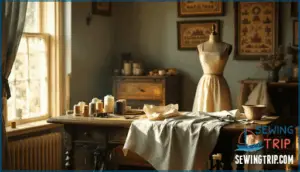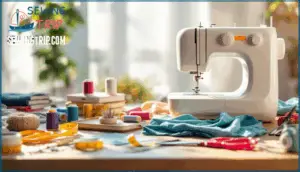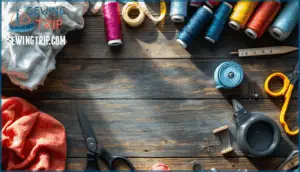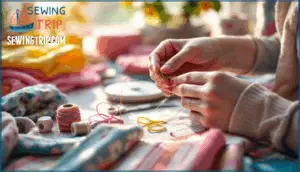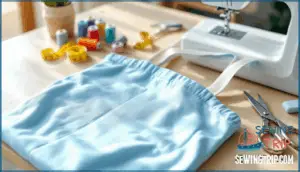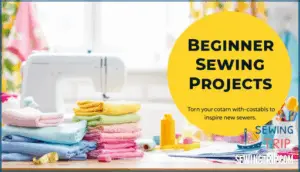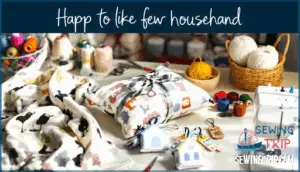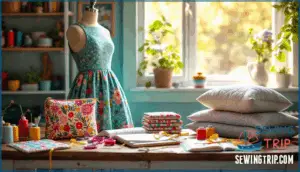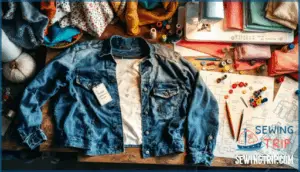This site is supported by our readers. We may earn a commission, at no cost to you, if you purchase through links.
 Most people think sewing is harder than it actually is. The truth? You can complete your first wearable project in about two weeks, even if you’ve never threaded a needle before. The confusion comes from mixing up "learning to sew" with "becoming an expert seamstress"—two very different things.
Most people think sewing is harder than it actually is. The truth? You can complete your first wearable project in about two weeks, even if you’ve never threaded a needle before. The confusion comes from mixing up "learning to sew" with "becoming an expert seamstress"—two very different things.
Learning the basics requires minimal investment: a starter kit runs $40 to $90, and the fundamental techniques take just a few practice sessions to grasp. The real challenge isn’t mastering complicated skills or buying expensive equipment. It’s sitting down, making inevitable mistakes, and pushing through that awkward beginner phase when your stitches look wonky and nothing sits quite right.
Once you understand what actually makes sewing difficult—and what doesn’t—you’ll see why thousands of complete beginners successfully teach themselves this skill every year.
Table Of Contents
- Key Takeaways
- Sewing Basics and Accessibility
- Historical Perspective
- Essential Sewing Requirements
- Sewing Tools and Equipment
- Fulfillment, Learning Pace, and Challenges
- Sewing Promotes Self-reliance, Ownership, and Control
- Learning a New Skill Contributes to Personal Fulfillment
- Increased Cognitive Ability in Learning and Creating
- Learning at Your Own Pace, Completing a Project Within Two Weeks
- Challenges Include Potential Loss of Focus, Procrastination, and Associated Solutions
- Sewing Lessons for Beginners
- Easy Sewing Projects for Beginners
- Starting With Projects Involving Straight Lines
- Choosing Projects With Minimal Intricacies
- Focusing on Household Items Like Blankets, Pillows, Burp Cloths, or Key Fobs
- Utilizing Online Platforms, Such as Pinterest, for Easy Sewing Patterns
- Gradually Progressing to More Complex Projects as Confidence and Skills Grow
- Taking It
- Frequently Asked Questions (FAQs)
- Conclusion
Key Takeaways
- You can complete your first wearable project in about two weeks with just a $40-$90 starter kit, proving that sewing basics are accessible to anyone regardless of age or previous experience.
- The real challenge isn’t mastering complicated skills or buying expensive equipment—it’s pushing through the awkward beginner phase when your stitches look wonky and mistakes pile up, which requires patience and determination more than natural talent.
- Starting with straight-line projects using beginner-friendly fabrics like cotton builds confidence quickly, while gradually progressing to more complex patterns develops real skills without overwhelming frustration.
- Sewing offers practical benefits beyond creating items—it boosts cognitive ability by 18% in workplace innovation, provides stress reduction through focused needlework, and builds genuine self-reliance that extends into other areas of life.
Sewing Basics and Accessibility
If you’re wondering whether sewing is within your reach, the answer is yes. Getting started doesn’t require years of training or an expensive setup.
Let’s look at what makes sewing accessible to beginners and what you’ll need to get going.
Easy to Learn With a Basic Sewing Kit
If you’ve been putting off learning to sew because you think you need a whole craft room full of fancy equipment, here’s some good news: a basic sewing kit is all it takes to get started. These beginner-friendly kits generally include essential sewing tools that won’t break the bank, and they’re designed specifically for sewing for beginners. Here’s what makes them so effective:
- Starter Kit Contents provide needles, thread, pins, and fabric scissors—everything needed for beginner projects
- Simple Project Selection guides you toward straight-line stitching before tackling complex patterns
- Beginner-Friendly Fabrics like cotton help you achieve Quick Wins without frustration
- Basic Stitch Mastery comes faster when you’re not overwhelmed by unnecessary tools
With this straightforward approach, you’ll build confidence through hands-on practice rather than collecting equipment you don’t yet need.
Simple Machine Operation Can Be Mastered in a Few Weeks
Once you’ve got your basic kit under control, you’ll be happy to know that learning to operate a sewing machine doesn’t require months of frustration—most beginners get comfortable with the fundamentals in just a few weeks. Start by familiarizing yourself with machine basics like threading practice and stitch settings. Don’t worry if the bobbin seems confusing at first—everyone struggles with it initially. Watch how the fabric feed moves material through, and you’ll quickly develop a rhythm.
Here’s what helps speed up your progress:
- Practice threading your machine daily until it becomes second nature, even if you’re not sewing a project
- Experiment with different stitch settings on scrap fabric to understand how tension and length affect your results
Regular maintenance tips, like cleaning lint and changing needles, will keep your machine running smoothly as you build confidence with sewing machine operation.
Anyone Can Learn Sewing, Regardless of Age or Experience
Whether you’re seven or seventy, sewing doesn’t care about your age or what you’ve done before—it only cares that you’re willing to try. This inclusive sewing craft offers universal accessibility that meets your learning process, making it perfect for anyone ready to build sewing skills.
- Age-neutral learning means beginners discover sewing techniques at their own comfortable pace
- Experience irrelevant—your first project matters more than your background
- Skill adaptability makes sure learning to sew meets you exactly where you’re at
Requires Patience, Diligence, and Determination
Learning to sew isn’t just about showing up—it’s about sticking with it when your first seam looks like a zigzag disaster and your thread tangles for the third time in a row. Patience helps you work through the learning curve without throwing your fabric across the room.
Diligence means practicing those straight stitches even when they’re crooked. Determination pushes you past frustration toward actual skill development.
Consistent effort transforms challenges into victories, and perseverance rewards you with garments you’re proud to wear.
Boosts Confidence and Productivity Through Focused Needlework
There’s something almost meditative about the rhythm of stitching—each careful movement builds not just a seam, but a sense of accomplishment that carries into every corner of your life.
As you navigate the learning curve, focused needlework becomes a mindfulness practice that quiets racing thoughts. Each completed project—no matter how simple—delivers confidence-building wins that spill over into other challenges.
The therapeutic benefits of sewing aren’t just nice extras; they’re real productivity gains that help beginners push through skill development roadblocks with clearer minds and steadier hands.
Historical Perspective
Sewing wasn’t always as simple as threading a machine and pressing a pedal. For centuries, people relied on hand stitching to create everything from everyday clothing to elaborate garments, making it a cornerstone skill passed down through generations.
Understanding how sewing evolved helps you appreciate the tools and techniques available to you today.
Historical Significance of Sewing
Sewing threads through human history like a needle through fabric, connecting us to our ancestors from 17,500 BCE. You might be surprised to learn that this everyday skill shaped civilizations and even won wars. Here’s how sewing left its mark:
- Paleolithic Sewing kept hunter-gatherers alive, using bone needles and animal gut to craft protective clothing against harsh climates
- Ancient Civilizations like the Han Dynasty elevated needlecraft to an art form, burying sewing tools with the honored dead
- Socioeconomic Impact turned seamstresses into valued tradespeople, with sewing skills serving as currency through bartering systems
- Wartime Sewing mobilized American women during WWII, boosting participation from 50% to 82% by 1944
The cultural significance of sewing extends beyond practicality—it’s woven into our shared human story, from prehistoric survival to modern textile arts and handmade items that carry meaning across generations.
The ability to sew provided essential protection from elements, guaranteeing survival during climate changes.
Evolution From Hand Sewing to Machine Sewing
For centuries, you’d’ve sewn every garment by hand—a slow, painstaking process. Then the Industrial Revolution changed everything. When inventors perfected the sewing machine in the early 1800s, sewing basics transformed overnight.
Machine operation could produce garments in hours instead of days, launching mass production and moving textile labor from homes into factories. This sewing innovation democratized fashion, making affordable clothing accessible to everyone.
Hand sewing became reserved for delicate work, while machines took care of the heavy lifting—boosting sewing skills and efficiency across the industry. Elias Howe's lockstitch was a remarkable invention.
Invention of The Sewing Machine Revolutionized Clothing Production
When the first practical sewing machines hit factories in the mid-1800s, they didn’t just speed up production—they sparked a revolution that changed how the world dressed. The textile industry shift was profound:
- Mass production slashed garment costs, making fashion accessible to working families
- Labor transformation moved sewing skills from homes to factories
- Machines social impact created new jobs while changing traditional roles
- Garment affordability meant you could own multiple outfits instead of one
- Sewing basics for beginners became simpler with mechanical assistance
This sewing machine advance democratized clothing like never before.
Present-day Sewing for Garments and Home Furnishings
Today’s sewing landscape lets you breathe new life into everything from fitted blazers to throw pillows, giving you creative control over your wardrobe and living space.
Modern sewing blends garment construction with home decor projects, letting beginners explore textile art without overwhelming sewing challenges. You’ll find sustainable sewing practices like upcycling fashion have become popular, transforming thrift store finds into custom pieces.
This hands-on approach puts creativity directly in your hands.
| Project Type | What You Can Create |
|---|---|
| Garments | Custom-fit dresses, altered jeans, unique tote bags |
| Home Decor | Curtains, cushion covers, table runners |
| Upcycling | Repurposed denim quilts, vintage fabric wall art |
Essential Sewing Requirements
Before you start stitching your first project, you’ll need to understand what sewing actually requires from you. It’s not just about having the right tools—it’s also about developing certain skills and knowing what you can realistically accomplish.
Here’s what you need to get started and succeed.
Basic Understanding of Sewing Techniques
Think of sewing techniques as the alphabet of creating with fabric—once you know your ABCs, you can spell out anything from a simple pillowcase to a custom jacket. Getting comfortable with basic sewing techniques means understanding a few fundamental concepts:
- How different stitch types keep fabric together
- Why fabric grain affects how your project hangs and drapes
- What seam finishes prevent fraying and add durability
- How pattern reading translates flat paper into three-dimensional pieces
These sewing basics form the building blocks for every project you’ll tackle.
Good Hand-eye Coordination and Attention to Detail
Your hands and eyes need to work together like dance partners—when one moves, the other follows without missing a beat. Precision cutting along pattern lines, seam accuracy within an eighth of an inch, and fine stitching all depend on this coordination.
You’ll develop attention to detail through the learning process, noticing when seams pucker or pattern matching goes off-kilter. These sewing skills improve naturally with practice—even wobbly beginners transform into steady stitchers within weeks. Detail work might feel awkward at first, but your brain quickly learns these sewing techniques through repetition.
Crafting for Personal Use, Creating Furnishings, Mending, and Fixing Household Items
Sewing lets you tackle everyday fixes and creative projects that make your living space feel more like home. Here’s what you can accomplish as a beginner:
- Mending torn clothes saves money and extends garment life
- Creating simple home decor like throw pillows or curtains personalizes your space
- Altering clothing provides better fit without expensive tailoring
- Upcycling old textiles transforms forgotten fabrics into something useful
- Making custom gifts adds thoughtful touches for loved ones
These beginner projects build essential sewing skills while tackling real sewing challenges, turning textile crafts into practical solutions you’ll use daily.
Proficiency With a Sewing Machine is Crucial for Success
While hand-sewing skills serve you well for quick fixes, learning to operate a machine transforms what you can create and how quickly you can make it happen. Understanding sewing machine basics—from stitch settings and needle types to fabric feeding and motor control—gives you the foundation for tackling ambitious projects with confidence.
- Threading feels tricky at first, but you’ll master it faster than you think
- Adjusting tension prevents frustrating thread bunches and skipped stitches
- Practicing on scrap fabric builds muscle memory before touching your real project
- Basic machine maintenance keeps your equipment running smoothly for years
Value in Handmade Items Even Without a Machine
Even without a machine, you can build real sewing skills and tap into a thriving handmade market valued at over 9 billion in the U.S. alone. Hand sewing lets you create income-generating items—from $8 accessories to $150 premium scarves—while keeping startup costs low. Consumer sustainability preferences are driving demand for artisan-made goods, and the artisan economic impact reaches far beyond individual sales, supporting entire communities.
Here’s what hand-sewn profitability looks like:
| Item Type | Price Range | Market Appeal |
|---|---|---|
| Small accessories | $4–$20 | High volume, quick turnaround |
| Embroidered pieces | $14–$15 | Moderate demand, individualized |
| Premium garments | $100–$150 | Niche buyers, quality-focused |
| Upcycled items | $10–$50 | Sustainability-minded customers |
Accessibility and value come from portability and precision that machines can’t always match, making hand sewing a genuine path forward for any beginner.
Sewing Tools and Equipment
Before you jump into your first project, you’ll want to gather a few basic tools that make sewing easier and more enjoyable. The good news is that you don’t need to break the bank to get started.
Here’s what belongs in your beginner toolkit.
Hand Sewing Needles, Thimbles, and Thread
Before you even thread your first stitch, you’ll need to pick the right needle, protect your fingertips with a thimble, and choose thread that won’t snap halfway through your project.
Needle types vary by fabric weight—sharps work for most beginner projects, while embroidery needles have larger eyes for thicker thread. Thread material matters too; cotton thread suits natural fabrics, while polyester offers durability. Thimbles prevent sore fingers during hand stitching.
Essential hand sewing supplies include:
- Sharp needles for general sewing and medium-weight fabrics
- Cotton or polyester thread matched to your fabric type
- Metal or leather thimbles to protect your pushing finger
- Needle threader for easier threading and less frustration
- Thread tension awareness to prevent puckering or loose stitches
Cutting Tools: Fabric Shears, Craft Shears, Seam Ripper
A sharp pair of fabric shears can be the difference between a professional-looking project and one that looks like it was chewed by a frustrated raccoon. Invest in quality fabric shears with comfortable grips—your wrists will thank you after hours of cutting. Reserve these shears exclusively for fabric; cutting paper dulls the blades faster than you’d think. Craft shears work well for patterns and non-fabric materials.
You’ll also need a seam ripper for fixing mistakes without damaging your fabric. This small tool has multiple seam ripper uses, from removing stitches to opening buttonholes.
Proper shear maintenance keeps your cutting accuracy sharp, making every beginner sewing project cleaner and more professional-looking.
Essential Measuring Equipment: Yardstick, Seam Gauge, Tape Measure
Without the right measuring tools, even perfectly cut fabric can end up looking like it was sewn by someone who thought "close enough" was an acceptable strategy. Accuracy matters more than speed when you’re learning measurement techniques. Start with a flexible tape measure for taking body measurements and checking curved seams. A clear acrylic yardstick helps you cut straight lines on fabric, while a seam gauge pinpoints smaller measurements like hems and button placement.
Keep your tape measure flat against fabric to avoid warping numbers, and store tools properly to prevent warping. These simple sewing tools transform guesswork into precision—and that’s when your beginner projects start looking impressive.
Additional Tools Like Needle Threader and Sewing Pins
Think of these small helpers as the difference between wrestling with your fabric and working alongside it. A needle threader saves frustration when your thread won’t cooperate, while sewing pins secure pieces exactly where you need them. Stock up on these essential sewing tools:
- Needle threader types: Wire loop or automatic styles for beginner level ease
- Specialty sewing pins: Glass-head, quilting, or ballpoint for different fabrics
- Pin organization methods: Sort by length and purpose in labeled containers
- Magnetic pin holders: Keep pins accessible and prevent floor disasters
- Pin cushion DIY: Repurpose small jars filled with sand or rice
Basic Sewing Tool Kit Can Be Assembled for $40 to $90
Getting started in sewing doesn’t require a fortune—just $40 to $90 will cover the essentials you need to begin creating. Budget toolkits from affordable brands offer everything required without sacrificing quality.
Your starter kit should include:
- Hand sewing needles in assorted sizes for different fabric weights
- Sharp fabric shears (8-inch length works for most projects)
- Seam ripper to fix mistakes without damaging fabric
- Measuring tape and seam gauge for accurate dimensions
- Quality thread in neutral colors like black, white, and beige
- Straight pins with glass heads that won’t melt under iron heat
These essential supplies form your basic sewing kit, with DIY alternatives available for pin cushions and storage solutions.
Fulfillment, Learning Pace, and Challenges
Sewing offers more than just the ability to make things—it gives you a sense of independence and pride in what you create.
The learning journey comes with its own rhythm, rewards, and roadblocks worth understanding upfront. Here’s what you can expect as you build this skill from scratch.
Sewing Promotes Self-reliance, Ownership, and Control
There’s something powerful about stitching your own seam and realizing you don’t need to rely on anyone else to fix a torn hem or create something from scratch. Sewing gives you creative independence and clothing autonomy.
You’re building real skills through a hands-on learning process, which brings DIY empowerment. Even when challenges pop up, like staying focused or working through mistakes, that’s part of skill mastery.
This self-reliance extends to mending culture, where you control what you make and how you fix things.
Learning a New Skill Contributes to Personal Fulfillment
When you pick up a needle and thread for the first time, you’re not just learning how to sew—you’re opening a door to something that can genuinely change how you see yourself. The benefits of sewing go beyond fixing a button.
Each stitch builds confidence and offers creative expression that’s entirely yours. This personal growth comes from skill mastery, where challenges of sewing become opportunities.
Learning to sew provides stress reduction and a real sense of accomplishment that sticks with you.
Increased Cognitive Ability in Learning and Creating
Sewing sharpens your mind in ways that might surprise you. Creative problem-solving becomes second nature as you figure out pattern adjustments or fix mistakes mid-project. Studies show that people who engage in creative hobbies like sewing can boost workplace innovation by 18%.
Your brain gets a real workout through:
- Memory protection — weekly sewing gives you 20% better recall by age 60
- Motor skill development — hand-eye coordination improves as you guide fabric and thread
- Mindfulness benefits — focused stitching lowers stress hormones and heart rate
The learning process itself builds new neural pathways. You’re strengthening attention to detail with every seam, while mood enhancement comes from completing each project. That sense of accomplishment isn’t just emotional—it’s your brain releasing dopamine, rewarding skill development in real time.
Learning at Your Own Pace, Completing a Project Within Two Weeks
You don’t need to race through your first project, but setting a two-week goal gives you something concrete to work toward without the pressure of flawlessness. Flexible scheduling lets you stitch a few seams during lunch breaks or dedicate weekend mornings to learning. Pick beginner sewing projects that match your current abilities—simple pillowcases beat complicated zippers every time.
Your learning process thrives when you:
- Set realistic goals that celebrate small wins, like mastering straight seams
- Track skill progression through photos of finished pieces
- Practice time management by blocking 30-minute sessions
- Adjust project selection as you discover what excites you most
Sewing challenges will pop up, but two weeks gives you room to troubleshoot without losing momentum.
Challenges Include Potential Loss of Focus, Procrastination, and Associated Solutions
Staying focused on sewing isn’t always easy. Distractions like phone notifications can derail your progress, while mental barriers—stress, poor sleep, or perfectionism—make even simple tasks feel overwhelming. Research shows that cognitive complexity affects how long projects take, and action complexity leads to more mistakes.
Here’s how to push through common challenges when learning to sew:
- Clear your workspace before starting—a tidy area sharpens attention and lifts your mood.
- Set bite-sized goals for each session, like finishing one seam instead of an entire garment.
- Silence interruptions by putting your phone in another room during stitching time.
Patience and small wins beat perfectionism every time.
Sewing Lessons for Beginners
Learning to sew doesn’t have to be a solo journey. You can find instruction in several places, from hands-on workshops to free advice from people who already know their way around a sewing machine.
Here’s where beginners usually turn for help.
Local Sewing Shops Offering In-store Lessons
Local sewing shops have become community hubs where beginners find the perfect blend of hands-on instruction and encouragement they need to get started. These in-store lessons usually run for a few hours each week, giving you direct access to experienced instructors who can answer questions on the spot. You’ll work through projects at your own pace while connecting with a sewing community that shares your interests. Many shops offer beginner-focused sewing classes at reasonable lesson costs, making it easier to compare options.
| What to Check | Why It Matters |
|---|---|
| Class Availability | Confirms schedules fit your routine and slots are open |
| Instructor Experience | Guarantees quality guidance from skilled teachers |
| Shop Reputation | Indicates reliable service and positive student outcomes |
Before signing up for sewing lessons, visit a few local shops to gauge their project variety and teaching style—this helps you find the right match for your learning journey, whether you prefer structured online sewing lessons or interactive in-store lessons.
Guidance From Friends or Relatives for Personalized Instruction
Learning from someone in your circle who already knows their way around a sewing machine can fast-track your progress with one-on-one attention you won’t find anywhere else. This custom mentorship lets them shape learning to your pace and answer questions as they come up. You’ll pick up sewing techniques through shared experiences—maybe even discover family heirlooms or generational skills passed down through the years.
When learning to sew with friends or relatives, you can expect:
- Real-time feedback as you practice basic stitches and adjust tension settings
- Hands-on demonstrations that show exactly how to thread needles or navigate tricky seams
- Encouragement that builds your confidence faster than solo sewing lessons ever could
This custom approach helps you master sewing skills in a comfortable, supportive environment.
Combining Online Lessons With Occasional Guidance From Experienced Individuals
Blending YouTube tutorials with the occasional hands-on advice from a skilled sewist gives you flexibility to learn on your schedule while still having someone to catch mistakes before they become habits. This hybrid learning approach combines the vast library of online lessons with individual feedback that reinforces proper technique.
You’ll find mentorship benefits through sewing classes or community support groups, where experienced sewers share insights that online resources can’t always provide. Sewing for beginners becomes less intimidating when you have multiple learning resources at your fingertips and real people cheering you on.
Embracing Mistakes as Part of The Learning Process
Every mistake you make while learning to sew isn’t a failure—it’s actually proof that you’re pushing yourself to try something new. Your sewing journey includes plenty of sewing errors, but each one teaches you something valuable about the learning process.
Mistake analysis helps you spot what went wrong so you can avoid repeating it. Overcoming frustration gets easier when you recognize that iterative improvement happens gradually.
Embracing imperfection on beginner sewing projects shortens your learning curve and keeps you moving forward.
Easy Sewing Projects for Beginners
When you’re just starting out, the right project can make all the difference. You’ll want to choose patterns that build your skills without overwhelming you.
Here’s what to look for in beginner-friendly sewing projects.
Starting With Projects Involving Straight Lines
Straight-line projects are like learning to ride a bike with training wheels—they give you the stability you need while you’re building muscle memory and confidence at the machine. Think simple seams on a tote bag or straight hems on a tea towel. These beginner sewing projects let you practice basic stitches without worrying about curves or tight corners.
Choose beginner fabrics like cotton or linen—they’re forgiving and won’t slide around as you work. Focus your project planning on items where mastering corners isn’t required yet. With the right sewing tools and a little patience, you’ll nail those straight seams in no time.
Choosing Projects With Minimal Intricacies
Simple projects with few moving parts are your best bet when you’re just getting comfortable with thread and needle. Look for beginner-friendly patterns with minimal seam complexity—think zipperless pouches or napkins with straight edges.
Quick sewing projects using easy fabric choices like cotton help you master basics without frustration. These simple sewing projects build your confidence while you’re choosing sewing projects that won’t overwhelm you. Start small, and you’ll develop solid skills fast.
Focusing on Household Items Like Blankets, Pillows, Burp Cloths, or Key Fobs
Once you’ve nailed those straight seams, household items like throw pillows, baby blankets, and simple key fobs make perfect practice projects that you’ll actually use. Pillowcase projects teach you envelope closures without complicated zippers.
Burp cloth fabrics like flannel are forgiving and soft, ideal for mastering your beginner blanket stitch. These easy sewing projects build real skills while creating DIY home decor.
With your basic sewing kit, you’ll gain hands-on experience that translates to more ambitious sewing for beginners down the road.
Utilizing Online Platforms, Such as Pinterest, for Easy Sewing Patterns
Pinterest and similar sites have become goldmines for beginner sewers hunting for patterns that won’t overwhelm them on their first try. You’ll discover free resources ranging from simple tote bags to zippered pouches, all with step-by-step photos.
Online tutorials and community sharing mean you can see real results before committing. These platforms offer instant project inspiration, helping you find sewing patterns that match your current skill level while building your confidence naturally.
Gradually Progressing to More Complex Projects as Confidence and Skills Grow
After a few successful runs with simple patterns, the real growth happens when you start eyeing projects that seemed impossible just weeks earlier. Your sewing journey naturally moves toward technique mastery as confidence building takes root. Consider these milestones in your skill progression:
- Easy zipper pouches that introduce closures without overwhelming complexity
- Simple gathered skirts for your first apparel adventure
- Quilted pot holders combining piecing and batting techniques
- Basic fitted pillowcases requiring precise measurements
Each project adds layers to your creative exploration while keeping project complexity manageable for steady sewing skill development.
Taking It
As you get comfortable with the basics, it’s time to stretch your abilities and tackle projects that really test what you’ve learned. This next phase of your sewing journey is where skill acquisition shifts into high gear. You’ll notice that patience, which got you through those first straight seams, becomes even more valuable as patterns grow more complex.
Here’s what taking it to the next level involves:
- Experimenting with challenging fabrics like knits, silk, or denim that demand a detail focus
- Trying patterns with zippers, buttonholes, or curved seams that require precision
- Using your math skills to adjust patterns for custom sizing or design modifications
- Adding your creative touch through embellishments, color blocking, or unique fabric combinations
- Building practice time into your routine, even when projects feel intimidating
Learning to sew doesn’t stop at mastering straight stitches. Push yourself toward garments with structure, home décor with multiple components, or even simple quilting projects. Each challenge strengthens your skills and proves what patience and determination can accomplish.
Frequently Asked Questions (FAQs)
How hard is it to learn to sew?
Imagine picking up a paintbrush for the first time—the learning curve feels steep at first, but teaching yourself to sew becomes manageable with practice and patience.
Building basic sewing skills gradually through beginner sewing projects while naturally overcoming frustration.
Is it hard to sew a fabric?
Sewing fabric isn’t inherently difficult—the challenge depends on fabric selection and basic sewing skills. Cotton and linen are beginner-friendly, while slippery silks or stretchy knits increase the learning curve.
Most beginner sewing projects use straightforward fabrics that work well with any sewing machine.
What is the hardest fabric to sew?
Ever tried wrestling with a fabric that just won’t cooperate? Sheer fabrics, slippery silks, stretchy knit fabrics, and coated fabrics top the list of challenging materials, demanding specialized sewing techniques and careful fabric selection to prevent fabric slippage and tension headaches.
Is sewing easy to learn?
Yes, sewing basics are easy to learn with accessible resources and beginner projects.
The learning curve is gentle if you start simple, practice regularly, and learn from common mistakes along the way.
Why is satin hard to sew?
Why does fabric that feels so luxurious slip right through your fingers? Satin poses challenges due to fabric fraying, slippage, and seam puckering. You’ll need proper needle types, adjusted sewing machine tension, and refined sewing techniques to manage this temperamental material successfully.
How do I learn to sew with a sewing machine?
You’ll master sewing machine basics by starting with machine threading, stitch settings, and fabric feeding.
Online sewing courses teach tension adjustment and maintenance tips.
Practice simple projects to build confidence with your machine’s core functions.
What are some common mistakes beginners make when learning to sew?
Beginners often skip mastering basic sewing techniques like proper threading and tension adjustment, leading to tangled messes. Rushing into complex projects without practicing cutting accuracy, seam allowance precision, or pressing techniques creates frustration. Ignoring fabric choice and avoiding help when stuck also slows progress.
Build your skills methodically through simple practice.
How can I find a local sewing community to connect with?
Connecting with fellow sewists enriches your learning journey and provides access to new techniques.
Local fabric stores often host in-store lessons and maintain bulletin boards where creative communities share opportunities. Check community centers for sewing guilds or workshops, and explore online forums and online sewing platforms to find groups meeting nearby.
What should I look for when buying fabric for a project?
Think of fabric shopping like choosing ingredients for a recipe—you need the right ones for success. Look for fabric weight that matches your project needs, and check the fiber content.
Natural fibers like cotton or linen offer breathability and durability, making them ideal for beginners.
Always review care instructions to guarantee the fabric suits your lifestyle.
What sewing machine features are most important for a beginner to have?
When choosing your first sewing machine, look for adjustable stitch length and a reverse function—these let you control your stitches and lock them in place. Speed control helps you work at a comfortable pace while you’re learning.
A built-in needle threader saves frustration, and interchangeable presser feet give you room to grow. A free arm makes sewing sleeves and cuffs easier.
Focus on these sewing machine basics rather than fancy features you won’t use yet.
Conclusion
You’ll face setbacks—threads tangling, seams puckering, patterns that don’t quite fit. That’s not a sign you’re bad at this; it’s proof you’re learning.
The question of how hard is sewing comes down to one thing: your willingness to keep going when your first few attempts look rough. Most people quit during that uncomfortable stretch between starting and getting good.
Push through it, and you’ll discover something valuable—not just a new skill, but the quiet satisfaction of making something with your own hands that actually works.

